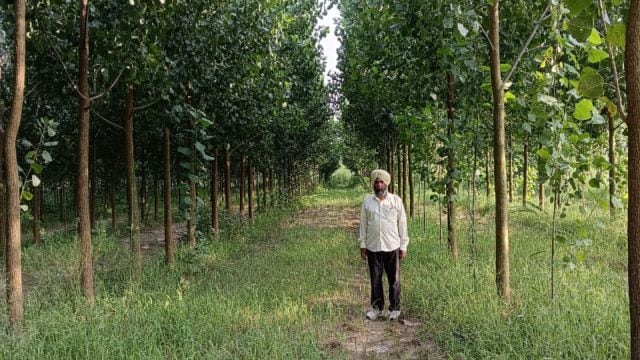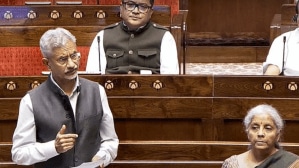Plant trees, grow wealth: A Punjab scheme is helping farmers earn, diversify & conserve
The initiative aims to encourage farmers to adopt agroforestry, which also paves the way for crop diversification, he adds.
 Yashpal Singh, 57, from Bhatoli village in Hoshiarpur (standing in his fields) received the first installment of Rs 20,800 in March this year for planting trees on 7 acres of his total 18-acre land.
Yashpal Singh, 57, from Bhatoli village in Hoshiarpur (standing in his fields) received the first installment of Rs 20,800 in March this year for planting trees on 7 acres of his total 18-acre land.Sukhjit Singh Sandhu’s (49) excitement knew no bounds when he received the first installment of Rs 41,250 transferred to his bank account by the Punjab government last year.
The cash subsidy came just a year after he joined the state’s government’s “Crop Diversification through Agroforestry” scheme, launched in 2022-23. Under the scheme, he was supposed to receive a cash subsidy for growing trees on his farmland. Initially, he started planting trees on just 2 acres and eventually expanded to the entire 8 acres, rotating crops in his field in Katohar village in Hoshiarpur.
“I was approached by Punjab Forest Department officials who asked me to fill out a form and submit land records,” says Sandhu, who began farming in 2010 after leaving a job in the corporate sector. Under the scheme, he was entitled to receive a fixed subsidy for growing trees in three installments.
Explaining the scheme, he adds that around 600 trees are planted per acre, and these trees are cut after 5-6 years for sale, after which new saplings are planted on the same land. “If one follows a rotation pattern — planting on 2 or 3 acres in the first year and repeating the process in subsequent years — farmers will start receiving income every year by selling these trees,” he says, adding that agroforestry is highly beneficial. Farmers who have other sources of income to survive in the initial years until the trees start generating income should consider starting with a portion of their land.
The initiative aims to encourage farmers to adopt agroforestry, which also paves the way for crop diversification, he adds.
Yashpal Singh, 57, from Bhatoli village in Hoshiarpur received the first installment of Rs 20,800 in March this year for planting trees on 7 acres of his total 18-acre land. “My fellow farmers are now ready to take up this initiative,” he says.
The good thing about the scheme, he adds, is that farmers are getting to start something new. “I also started growing trees just a couple of years ago, and this scheme has been a big help in the beginning as it covers at least some input costs, thus reducing the fear of loss,” he says, adding that he is planning to increase the area under tree cultivation.
Sandhu and Yashpal are among the 6,049 farmers who enrolled for direct benefit transfer payments under the Punjab government’s CDAF scheme.
According to the Forest Survey of India’s (FSI) 2021 data, only 5.92% of Punjab’s area is under forests. This highlights the urgent need to increase the green cover of the state.
With 84% of Punjab’s geographical area dedicated to agriculture, the state’s heavy reliance on traditional crops such as wheat and paddy has led to significant environmental concerns, including the alarming depletion of groundwater and severe air pollution from crop residue burning. By integrating agroforestry, farmers can diversify their land use, reduce reliance on water-intensive crops like paddy while conserving natural resources, experts say, adding that Punjab farmers also grow eucalyptus and poplar trees.
Saurabh Gupta, IFS, Additional Principal Chief Conservator of Forests (Development), says, “Key features of the CDAF programme include financial assistance based on a per-plant, per-hectare basis as well as for both high and low-density plantation areas.”
“The amount of subsidy per plant for Peripheral Boundary Plantation & Low Density Block Plantation Models is Rs 50 per plant for clonal eucalyptus to be given at Rs 25, Rs 12.50 and Rs 12.50 per plant, respectively, in three years and Rs 60 per plant for all species other than clonal eucalyptus to be given at Rs 30, Rs 15 and Rs 15 per plant, respectively, in three years. The amount of subsidy per hectare for the block plantations of (High Density Block Plantation) is Rs 31250 to be given at Rs.15625, Rs 7813 and Rs 7813 in three years for clonal eucalyptus and Rs 37500 per hectare to be given at Rs 18750, Rs 9375 and Rs 9375 in 3 years for all species other than clonal eucalyptus,” says Gupta, adding that farmers are the owners of the trees and their proceeds.
The programme also has a mobile app for registration, field verification, and subsidy calculation, ensuring transparency and efficiency.
“The eligible farmers who have planted trees can register themselves in the nearby office of the Department of Forests & Wildlife Preservation by applying in the prescribed performa along with copies of aadhaar card of farmer linked bank account of the farmer, copy of ‘dard’ jamabandi (land record) and girdawari (assessment) of the land of the farmer where plantation is done,” said Sanjeev Tiwari, Forest Conservator of North Circle, adding that after verification they become eligible for subsidy.
According to the department, in 2022-23, there were 3,109 beneficiaries who were given Rs 7.87 crore for planting 36.35 lakh saplings. In 2023-24, 2,940 beneficiaries planted 34 lakh saplings and Rs 7.78 crore will be released for them in 2024-25. Officials added that payments of 2023-24 got delayed because of elections, but the payments will soon be transferred to their accounts.
“The CDAF scheme has the potential to become a major initiative in a state where groundwater levels are declining by 80-90 cm annually in many areas. With this scheme, several farmers can divert some of their land to agroforestry, which will save a significant amount of groundwater,” an expert says.












